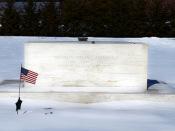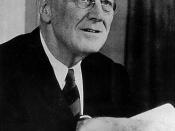RooseveltÃÂs responses aided curtail the problems of the Great Depression by employing the unemployed, aiding the businesses, and restoring confidence in a very panicked public. He alleviated the poorest classes by enacting laws that provided them with safety nets and even some capital to get started with. By raising the standard of living for the desperately poor, he increased the number of able consumers to buy businessesÃÂ goods and decreased the number of people living in the streets, which in turn set off the reactions that improved all other aspects of American life, thereby beginning to restore the pre-depression conditions.
The Chinese proverb goes, ÃÂGive a man a fish and you feed him for a day. Teach a man to fish and you feed him for a lifetime.ÃÂ This ÃÂteaching a man to fishÃÂ was exactly what Roosevelt did to millions of unemployed and underemployed Americans. He reallocated wealth to those who truly needed it.
He didnÃÂt want the recipients to remain entirely dependent on the help, as demonstrated by the New Deal act that gave those in poverty a little bit of money so that they had somewhere to start from when getting up and going job-hunting. There was some uneven distribution of this help, as clearly illustrated in Document I. Blacks, women, and immigrants were clearly discriminated against everywhere. As illustrated by Document J, the number of unemployed citizens dropped significantly during the Roosevelt years. Sometimes he would attack multiple issues with his programs, such as when he fought both unemployment and lack of natural resource conservation by creating the CCC. One fascinating thing that Document J reveals is how much more unemployment there was in the urban areas, since taking away the low unemployment rates of the farm-workers raised the overall rate from about 25 to 37,


